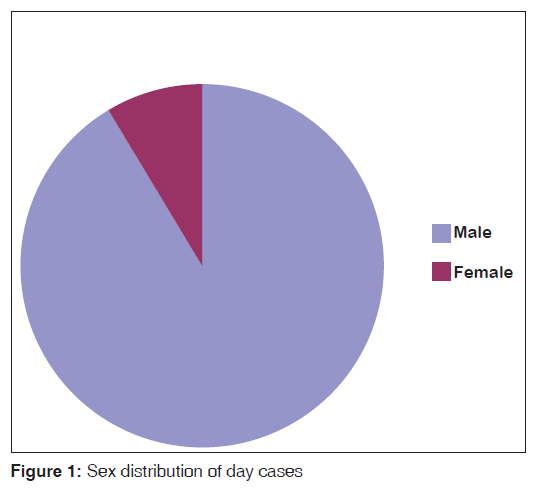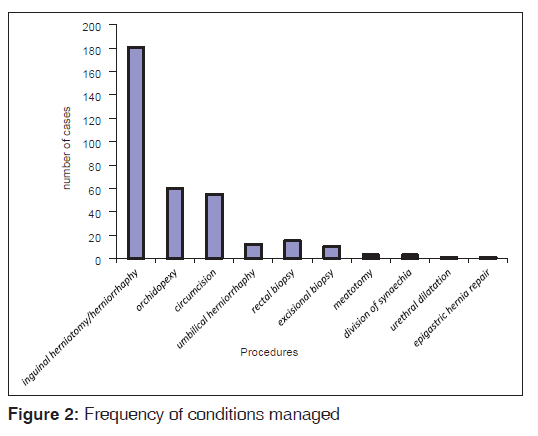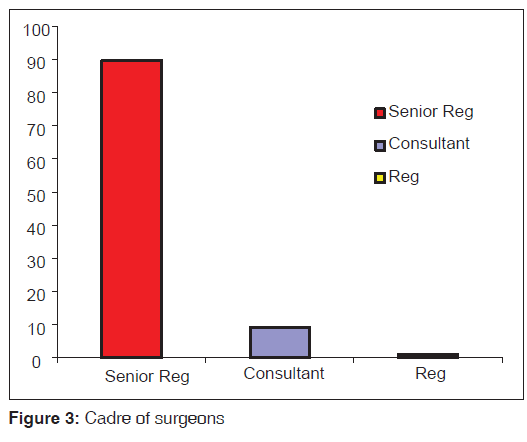Pediatric Day Case Surgical Practice at a Tertiary Hospital in Lagos: How Have We Faired?
- *Corresponding Author:
- Dr. Olumide A Elebute
Paediatric Surgery Unit, Department of Surgery, Lagos University Teaching Hospital, PMB12003, Idi-Araba Lagos, Nigeria.
E-mail: doctoroae@yahoo.com
Abstract
Background: There has been a gradual increase in the number of patients treated as a day case surgery in our center. This study has been conducted to audit pediatric day case surgery practice at the Lagos University Teaching Hospital. Aims: The aim of the following study is to determine the morbidity and mortality from day case surgery in our center. Subjects and Methods: The type of study was a prospective study over a 2½ year period at the Lagos University Teaching Hospital. The patients scheduled for surgeries were assessed in the pediatric outpatient clinic and information obtained for each of the patients included age, sex, diagnosis and operation planned. Additional information collected included the (1) type of anesthesia (2) post‑operative complications and the cadre of the surgeon. The data was analyzed using SPSS version 19 (IBM Corp. Released 2010. IBM SPSS Statistics for Windows, Version 19.0. Armonk, NY: IBM Corp, USA). Result: A total of 381 patients were operated during the study period. The age range of patients was 2 weeks to 15 years and the mean age was 2.9 years (3.0). There were 338 male patients (88.7%;338/381) and 43 females (11.3%;43/381). Inguinal hernias and hydroceles constituted almost half of the cases treated while 16.0% of cases were undescended testis. There were four morbidities and no mortality. Conclusion: Day case surgery is associated with a low morbidity and no mortality in our center.
Keywords
Day case surgery, Morbidity, Mortality, Procedures
Introduction
Day case surgery is defined as planned surgical procedures on patients admitted and discharged home on the day of their surgery that require some facilities and time for recovery.[1] The world-wide popularity of day case surgery derives from its many benefits including the reduction in waiting time, lowered cost of hospitalization as well as reduced risk of hospital acquired infection, psychological and emotional impacts common with in-patient admissions.[2] In children, behavioral, sleep pattern disturbances and disruption of family life are all equally avoided by outpatient management.[3]
In general, children are excellent candidates for day case surgeries as they are usually healthy and free from systemic diseases or degenerative changes common with older subjects.[4]
Since the inception of pediatric day case surgery at the Lagos University Teaching Hospital in the early 1990’s, there has been a progressive increase in the volume of patients load managed. However, no study has been conducted to evaluate and audit the day case surgery since its inception.
Subjects and Methods
The study is a prospective study over a 2½ year period at the Lagos University Teaching Hospital. Ethical approval for the study was obtained from the Hospital’s Ethical Committee. The patients scheduled for surgery were assessed in the pediatric outpatient clinic and the following information was obtained for each of the patients: Age, sex, diagnosis and operation planned. Additional information that was collected included the (1) type of anesthesia (2) post-operative complications (i.e. early and intermediate) as well as the final outcome (alive or dead) and the cadre of surgeon. Patient selection for day case surgery followed institutional laid down protocol which included parental or caregiver’s consent to day case surgery on their wards and their willingness and ability to offer supportive post-operative care to the patient at home; a pre-operative baseline hematocrit value ≥30% and normal blood chemistry parameters, short surgical procedure not associated with significant loss of blood and post-operative pain; exclusion of patients with comorbidities such as bleeding disorders such as hemophilia, hemoglobinopathies, asthma and cardiac abnormalities and those with respiratory tract infections. The patients are further reviewed by either a specialist anesthetist or anesthetic residents on the morning of their proposed surgery to ascertain their fitness for surgery. The data collated were analyzed using SPSS version 19 (IBM Corp. Released 2010. IBM SPSS Statistics for Windows, Version 19.0. Armonk, NY: IBM Corp, USA).
Results
A total of 381 patients were operated over a 2½ year period. The age range of patients was 2 weeks to 15 years and the mean standard deviation age was 2.9 (3) years (95% confidence interval = 2.6-3.2). There were 338 male patients (88.7%; 338/381) and 43 females (11.3%; 43/381) [Figure 1]. Inguinal hernias and hydroceles constituted almost half of the cases treated (49.0%; 187/381) and 61 (16.0%; 61/381) of the cases were undescended testis. Superficial lesions such as subcutaneous lipoma, dermoid cyst and implantation cyst accounted for 3.4% (13/381) of the cases. Other conditions seen are as shown in Figure 2.
Inguinal herniotomy was indicated in 181 patients (47.5%; 181/381) two patients had both an inguinal herniotomy and an umbilical herniorrhaphy (0.5%; 2/381). Ten patients had umbilical herniorrhaphy (2.6%; 10/381). Other procedures performed are as shown in Table 1.

Totally 342 patients had surgery performed under general anesthesia (89.8%; 342/381); 41 of the cases (10.8%; 41/381) were done with the aid of local anesthesia and 3 (0.8%; 3/381) had surgery under conscious sedation. The choice of the type of anesthesia was primarily based on the type of procedure and the age of the patient and secondarily on financial prowess of the parents. Circumcision was performed using local anesthesia for patients <3 months of age. Some cases of full-thickness rectal biopsies were performed under conscious sedation instead of general anesthesia when finance was a limiting factor as the former was more affordable to the parents.
Totally 342 cases (89.8%; 342/381) were performed by senior registrars and 35 by consultants (9.2%; 35/381). Four cases were handled by junior registrars (1.0%; 4/381) [Figure 3].
There was no mortality during the study period, but there were four morbidities. There were two cases of surgical site infection and a case each of recurrent inguinoscrotal hernia and post-operative bronchospasm.
Discussion
The pediatric day case unit of the Lagos University Teaching Hospital is of integrated variety that boasts of a team comprising surgeons, anesthetists, nurses as well as supportive staff, which include two anesthetic technicians and one porter/cleaner.
Since, the commencement of pediatric day case surgery in the Lagos University Teaching Hospital in the 1990’s there has been a gradual rise in the volume of patients treated on a day case basis. However, no study has been conducted to evaluate and audit the day case surgery unit since its inception.
In a study of day case surgery in Ile-Ife, Southwest Nigeria by Agbakwuru et al. where the age bracket of patients operated was 3 months to 97 years, patients <10 years accounted for 32.8% of the total cases.[5] Lump excision and hernia repair constituted the bulk of procedures performed. The complication rate was 10.5%.[5] Our complication rate was 1.7% and this could be due to the fact that our study was limited to children and co-morbidities that are commonly seen in much older subjects are generally rare in children.
Similarly, in a prospective study by Ojo et al., 311 of a total 1,024 elective cases were performed as day surgeries.[6] This accounted for 30.4% of the total number. Pediatric patients made up 15.8% of the total day case population.[7] Endoscopies, lump excision and herniotomy constituted most of the cases done in the entire study.
In another study conducted by Abdur-rahman et al. 68.02% of pediatric elective cases were carried out on a same day basis.[8] The male to female ratio was 14.3:1 and the age range of patients in the study was between 20 days and 15 years. Hydroceles and hernias accounted for 71.2% of the total indications for surgery which is similar to the findings from our study. There was no mortality in this same study, neither was there any unplanned admission.[8]
The findings from these studies are similar to our own study as the bulk of cases we treated were hydroceles and hernias. As with Abdur Rahman’s report, our study showed a male preponderance of ratio 8:1. We did not record any mortality, but there was one unplanned admission (1%). This was necessitated in a child who was scheduled for herniotomy but eventually developed an unexplained hyperactive airway during intubation.
Calder et al. in their own study of 804 children over a 4 year period obtained a complication rate of <1% and an unplanned admission of 1% which in their review, corresponds to the findings of many other centers. They attributed this to their having both a dedicated day case unit and a dedicated staff, capable of proffering standard care.[9] Also noted in their review was the role of proper patient selection which permitted only patient without any risk of anesthetic complications for day case surgery.[9] We believe proper patient selection is also cardinal to the low morbidity and mortality we observed from our study.
Conclusion
Day case surgery is associated with a low morbidity and no mortality in our setting.
Source of Support: Nil.
Conflict of Interest: None declared.
References
- Abdulkareem IH. Day case surgery in Nigeria. Niger J Clin Pract 2011;14:383-9.
- Gangadhar S, Gopal T, Sathyabhama, Paramesh K. Rapid emergence of day-care anaesthesia: A review. Indian J Anaesth 2012;56:336-41.
- Upadhyaya M, Lander A. Day case surgery in children. Surgery 2013;31:140-4.
- Erden IA, Pamuk AG, Ocal T, Aypar U. Parental satisfaction with pediatric day case surgery. Middle East J Anesthesiol 2006;18:1113-21.
- Agbakwuru EA, Faponle AF, Adesunkanmi AR, Ogundoyin O. Practice and acceptance of day-care surgery in a semi-urban Nigerian hospital. East Afr Med J 2001;78:170-3.
- Ojo EO, Ihezue CH, Sule AZ, Dakum NK, Misauno MA. The safety of day case surgery in a developing country. J One-Day Surg 2008;18:13-8.
- Ojo EO, Ihezue CH, Sule AZ, Ramyil VM, Misauno MA. The scope and utilisation of day case surgery in a developing country. East Afr Med J 2007;84:200-6.
- Abdur-Rahman LO, Kolawole IK, Adeniran JO, Nasir AA, Taiwo JO, Odi T. Pediatric day case surgery: Experience from a tertiary health institution in Nigeria. Ann Afr Med 2009;8:163-7.
- Calder F, Hurley P, Fernandez C. Paediatric day-case surgery in a district general hospital: A safe option in a dedicated unit. Ann R Coll Surg Engl 2001;83:54-7.







 The Annals of Medical and Health Sciences Research is a monthly multidisciplinary medical journal.
The Annals of Medical and Health Sciences Research is a monthly multidisciplinary medical journal.